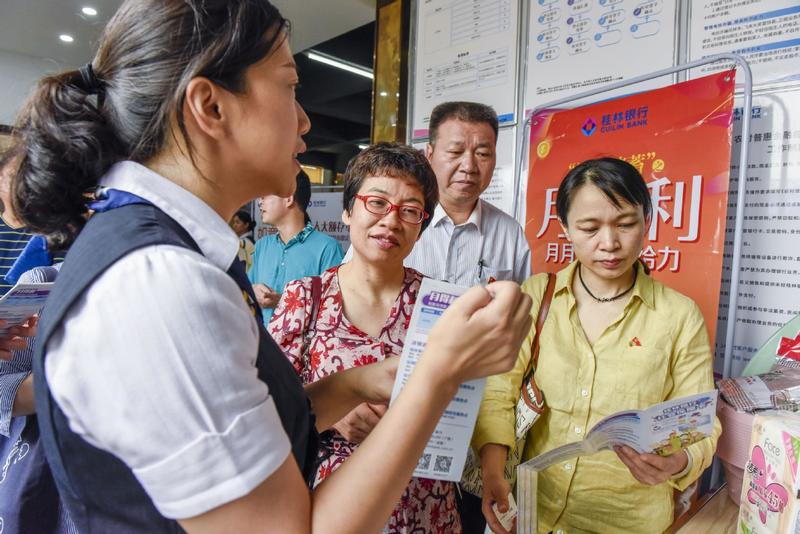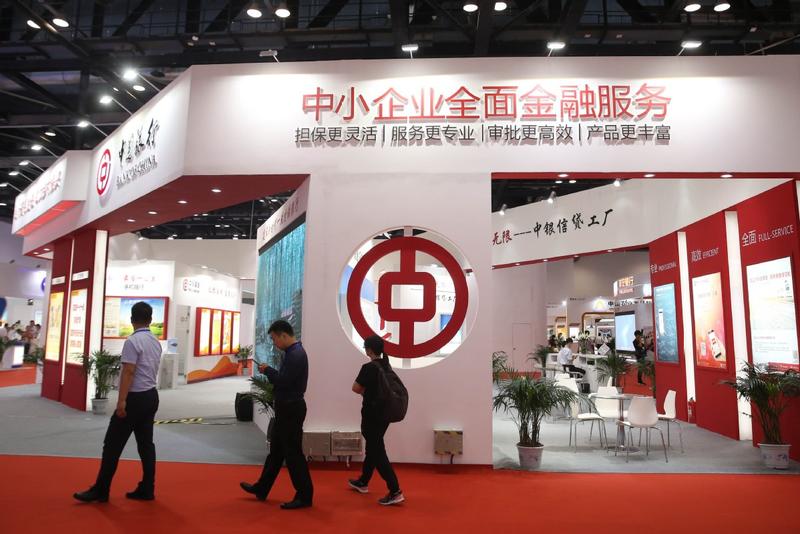 In this undated file photo, an employee from a rural inclusive finance comprehensive service center in Nanning, Guangxi Zhuang autonomous region, introduces various financial products to consumers. (PENG HUAN / CHINA DAILY)
In this undated file photo, an employee from a rural inclusive finance comprehensive service center in Nanning, Guangxi Zhuang autonomous region, introduces various financial products to consumers. (PENG HUAN / CHINA DAILY)
Chinese monetary authorities and banking regulators have adopted supportive measures to increase loans to small and micro businesses to mitigate the negative effects of the COVID-19 pandemic and encourage market entities to employ new financing tools to boost production, according to officials and bank executives.
According to data released by the CBIRC official, as of the end of July, the outstanding loans of small and micro companies reached 40.83 trillion yuan (US$5.98 trillion), up 10.62% from the beginning of the year
"The outstanding small and micro loans issued by China's biggest five banks increased 37.1 percent in the first seven months, and for the whole year, their new loans may exceed the target set by the Government Work Report in May-40 percent year-on-year growth," said Mao Hongjun, an official from the China Banking and Insurance Regulatory Commission, at a recent meeting.
According to data released by the CBIRC official, as of the end of July, the outstanding loans of small and micro companies reached 40.83 trillion yuan (US$5.98 trillion), up 10.62 percent from the beginning of the year.
Regulators also relaxed standards for bad loans, tolerating higher nonperforming loan ratios for small and micro firms. The ratio is now permissible to be 3 percentage points higher than the required NPL ratio level for regular loans, Mao said.
The official NPL ratio was reported at 1.94 percent at the end of the first half. The CBIRC aims for full-year NPL resolution of 3.4 trillion yuan this year, of which 1.1 trillion yuan was completed in the first half. This compares with the 2.3 trillion yuan of NPLs resolved in 2019.
ALSO READ: PBOC plans bank loan buyback to lift SME lending
Given the slower economic growth disrupted by COVID-19 globally, many countries will face a recession this year, an unprecedented situation in modern times. This predicament will also lead to deteriorated credit quality and lower banking profits, analysts said.
Fitch Ratings said that most Chinese banks believe the deterioration in consumer NPLs peaked in the second quarter, and the situation has moderated since June.
Chinese banks reported that their aggregate net profit fell 9.4 percent year-on-year in the first half to 1 trillion yuan, the official data showed, especially due to higher expected credit losses and lower net interest margins related to the rate cuts of the People's Bank of China, the central bank.
To encourage bank lending in such an environment, the central bank's branch in Nanjing, Jiangsu province, decided not to investigate and place responsibility on about 21,000 front-line officers who might have issued loans with some risks.
 In this undated file photo, visitors walk past the Bank of China booth during the sixth China SME Investment & Finance Expo in Beijing. (CHEN XIAOGEN / CHINA DAILY)
In this undated file photo, visitors walk past the Bank of China booth during the sixth China SME Investment & Finance Expo in Beijing. (CHEN XIAOGEN / CHINA DAILY)
This measure has helped to eliminate banking institutions' concerns over potential risks and accountability, said Guo Xinming, head of the PBOC's Nanjing branch. And the loans have been secured by the local government's financing guarantee system, as well as export credit insurance.
In order to boost credit growth and spur economic development, monetary authorities have injected more liquidity into the financial sector and adopted a more flexible monetary policy
In Suzhou, Jiangsu province, the local government built the nation's first digital credit information pilot site, which has supported the issuance of 100 billion yuan in loans for small and micro firms, Guo said.
In a province in which manufacturing contributed to more than 30 percent of its GDP, the central bank's local branch promoted bank lending to manufacturing companies, and medium to long-term lending increased by 26.1 percent year-on-year by July, which was 10.6 percentage points higher than the level in the same period last year, the official said.
"We strengthened financing support of the development of the internet of things in Wuxi (Jiangsu) and the biomedical industry in Taizhou (Zhejiang province), as well as Jiangsu's traditional industries such as petrochemicals, metallurgy, textiles and building materials, so as to meet the financing needs of enterprises," Guo said.
In order to boost credit growth and spur economic development, monetary authorities have injected more liquidity into the financial sector and adopted a more flexible monetary policy. The central bank also innovated monetary policy tools to extend bank loan repayments and purchased qualified credit loans in order to prevent tighter refinancing conditions and make credit provisions to the real economy much easier.
The nation's tax authorities, meanwhile, exempted value-added taxes on the interest income of small and micro loans.
"Loans typically increase faster in the first half for Chinese banks," said Grace Wu, a senior director with Fitch (Hong Kong). "But banks' top-line growth is challenged by compression of their net interest margins.
"While most banks are nearing completion of their transition to using the loan prime rate as their benchmark, broader government directives to reduce borrowing costs will continue to suppress asset yields for banks. The fierce deposit competition will, however, push up funding costs," Wu said.
READ MORE: Online lending alliance to ease credit crunch of SMEs in China
Moody's Analytics, a financial intelligence company, expects China's aggregate financing (including the bank lending) will maintain the current growth pace to stimulate the economy, with no further cuts of the loan prime rate or reserve requirement ratio made by the central bank. The company projected China's GDP to grow by 3.3 percent year-on-year in 2020, with growth accelerating to 9.4 percent next year.
In August, Chinese banks extended more new loans denominated by yuan than in July, indicating that continued policy support will keep the economy on an even keel and help it recover from COVID-19.
Banks extended 1.28 trillion yuan in new yuan loans in August, up from 992.7 billion yuan in July, said the PBOC.
Aggregate financing, the total financing amount going to the real economy including government bonds, reached 276.74 trillion yuan by the end of last month, up 13.3 percent on a yearly basis.


